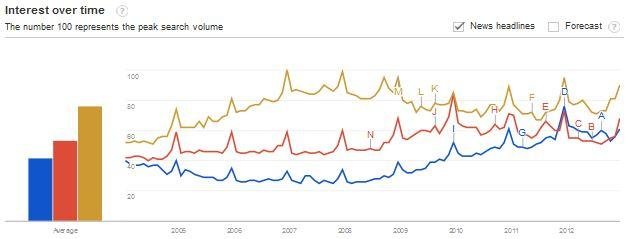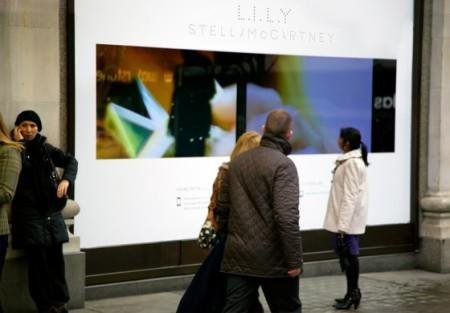Introduction
Background to the study
The global luxury industry has undergone remarkable evolution over the past five years despite the turbulent global economic environment. Some of the markets that have witnessed strong performance include the Latin America, Europe, China, and the United States. A report released by Bain & Company in 2012 projected that the global luxury market would grow with 10% in 2013 (Reed 2012).
One of the issues that consumers of luxury fashion products are increasingly focusing on relates to a high level of personalisation at different organisation touchpoints. The core motive is to achieve a unique experience. This trend has emerged from the improvement in the level of information amongst consumers, which is changing how consumers engage with products.
This aspect has motivated fashion retailers to incorporate digital media platforms in their operations. Wiedmann, Hennigs, and Siebels (2007) assert that luxury is concerned with the consumers’ emotion. Adopting digital mediums in their marketing process can provide luxury firms with a higher competitive edge as compared to print mediums.
Purpose
The purpose of this report is to appraise the future of digital with regard to luxury consumer experience. The report specifically focuses on fashion retailers by assessing the application of digital techniques and technologies in Stella McCartney’s operation. The report assesses how the firm utilises digital platforms in improving consumer experience.
Analysis
Company profile; Stella McCartney Limited
Stella McCartney Limited is a renowned fashion house, which was established in 2001 in the United Kingdom through a joint venture with Gucci. The firm specialises in designing and producing ready-to-wear products, fragrances, lingerie, and eyewear. Some of its products include jackets, denim, pants, skirts, handbags, shoes, trousers, dresses, knitwear and coats (Stella McCartney 2014).
Over the past decade, Stella McCartney has established 33 freestanding stores some of which include London Mafair, Manhattan’s Soho, Beijing, Shanghai, Milan, Paris’ Palais Royal, Los Angeles West Hollywood, and Tokyo.
In an effort to improve the brand’s market share, Stella McCartney has penetrated in over 70 countries by establishing over 600 wholesale accounts such as departmental stores and speciality shops. Furthermore, the firm distributes its products through online mediums.
Consumer profile
The firm has targeted women as its core customer group. The firm is focused at establishing a strong market position in the feminine market. However, the firm has diversified into kids products. The firm’s market targeting strategy is based on the consumers’ purchasing power.
Subsequently, the majority of the firm’s customers include high-end and affluent consumers. During its 2013 financial year, Stella McCartney’s sales revenue grew with a margin of 25% to £ 25.7 million. On the other hand, the firm’s profit increased with a margin of 38% to £ 4.6 million (Watkins 2013).
Competitor analysis
Different industry players have ventured into the industry in an effort to exploit the market demand (Wiedmann, Hennigs & Siebels 2007). Stella McCartney faces intense competition from Louis Vuitton Moet Hennessy (LVMH), which is the leading fashion conglomerate.
Other major competitors include the PPR Gucci Group, Burberry, Valentino Fashion Group, Christian Dior, Yves Saint Laurent, Giorgio Armani, Hermes, H&M, Jimmy Choo, and Bottega Veneta (Louis Vuitton Moet Hennessy 2014).
The Porter’s five forces
- Threat of new entrant [high] – the industry is characterised by the high threat of entry due to the minimal capital requirement in starting a clothing line.
- Supplier bargaining power [low] – the industry suppliers have minimal bargaining power due to the limited extent to which the suppliers can differentiate their products.
- Buyer bargaining power [high] – the luxury market is characterised by a large number of industry players, which means that the consumers’ switching cost is relatively low.
- Threat of substitute [moderate] – fashion clothes have no perfect substitutes. However, consumers are increasingly adopting the concept of online shopping, which provides an opportunity to select from different consumer groups.
- Rivalry [high] – The degree of industry rivalry is relatively high due to the large number of small and large market players.

Application of technology in creating unique customer experience
According to Louis Vuitton Hennessy Moet (2014), digital media has transformed the luxury market, as evidenced by the high rate at which consumers are using technology whilst searching for product information. A significant growth in the level of web search interest amongst consumers for Louis Vuitton (illustrated in blue), Gucci [red], and Chanel Company [yellow] over the past few years as illustrated by the graph below.

For a considerable duration, luxury marketers were not concerned with the role of technology in improving their competitiveness. However, this trend changed in 2010 with the arrival of new technologies such as the iPad.
The adoption of luxury products by affluent consumers motivated fashion marketers to adopt digital technologies. This trend has arisen as luxury retailers are appreciating the view that creating a unique customer experience is not only based on the product, but also on how the service is delivered.
Consumers have become technologically perceptive over the past decade due to the increased access to the high rate of technological innovation. Some of the technologies that have revolutionised how marketers deliver customer experience include the emergence of the Internet.
Furthermore, the rapid development and adoption of mobile devices such as iPads and social media have improved the effectiveness with which marketers interact with their customers in an effort to create a unique shopping experience (Baines 2009).
According to Doran (2012, par.1), ‘both luxury brands and consumers are showing a commitment towards integrating technologies and building connections between online and offline communications’.
Major luxury houses such as Louis Vuitton, Christian Dior, and Burberry are becoming innovative in an effort to create a unique in-store customer experience. Thomas (2014, par.9) emphasises that these stores ‘are using a large, brand-wide scale for off-the-shelf goods, and an intimate personal service level for bespoke goods’.
Stella McCartney has also adopted emerging technologies in an effort to create unique customer experience. In 2012, Stella McCartney developed an interactive campaign, which entailed establishment of a touch-point and interactive video that had the capacity of detecting passers-by using Microsoft-Kinetic cameras.
Doran (2012, par.6) asserts that the ‘passers-by motion triggered a switch from a pre-set video content to exclusive behind the scene video of Malgosia Bela during a campaign shoot’. The image below illustrates the firm’s interactive digital video outside the company’s building.

Promotional campaign
The intensity of competition in the luxury market is an indicator that Stella McCartney should improve its competitive advantage. Changes in the consumers’ purchasing behaviour further highlight the need for Stella McCartney, improving its competitiveness.
One of the aspects that the fashion house should be concerned with entails how to create a unique customer experience, which can be achieved through effective marketing and incorporation of online and offline technologies.
Stella McCartney should adopt an effective promotional campaign in order to improve the brand’s competitiveness during the Autumn-Winter 2015 season by incorporating technology in its promotional campaign. Some of the issues that the firm’s marketing department should consider are evaluated herein.
Product strategy
The firm should consider improving the quality of its products. In its product design stage, Stella McCartney should incorporate effective product design technology by utilising the state-of-the-art CAD fashion design system.
This technology will enhance the level of creativity amongst the fashion designers. In its product development process, Stella McCartney should focus on ensuring that its products are eco-friendly. One of the ways through which this goal can be achieved is by utilising renewable raw materials in producing its luxury products. Moreover, the firm will invest in developing its luxury products from biodegradable materials.
Considering the high rate of global warming, firms have an obligation to adopt the concept of environmental sustainability. For example, in the process of developing its eyewear products, Stella should consider utilising natural raw materials such as castor-oil seeds. Utilising eco-friendly raw materials will improve the likelihood of the firm developing a strong public image.
The high rate of climate change has motivated consumers to incline towards consuming products that do not lead to environmental pollution. This trend has arisen from the view that consumers are now informed on how organisations operations increase the rate of environmental pollution. However, the firm should utilise technology to ensure that its products are eco-friendly.
Pricing strategy
Stella McCartney should adopt a premium-pricing strategy, which will entail setting the price of its luxury products at a high price point. This aspect will aid in communicating value to the target high-end consumers. Most luxury consumers associate high price with value and quality of the product.
Distribution strategy
Stella McCartney should ensure that its products are easily accessible in the market. Subsequently, the firm should adopt an effective and efficient distribution strategy by establishing an online store, among others.
Adams (2013, par.3) asserts that luxury consumers ‘value easy shopping and a product experience that actually feels luxurious’. Establishing secure online store will provide consumers with an opportunity to shop from the luxury of their home, thus allowing the firm to improve its sales revenue.
Promotion strategy
The firm should incorporate emerging technologies in its shopping process. Some of the technologies that the firm should incorporate include social media such as Facebook, Twitter, MySpace, Flickr, YouTube, Google+, and WhatsApp. These social media platforms will provide the firm with an opportunity to create sufficient awareness of its luxury products in the global market.
Additionally, the firm should also consider creating awareness through the various mobile devices by designing a mobile application that will enable Smartphone owners to achieve in-store experience through their mobile devices. For example, the firm should develop videos of renowned celebrities such as sports and music celebrities endorsing its products and post them on the different social media platforms.
Furthermore, the firm can develop pictures of renowned personalities shopping at its stores. It is also imperative for the firm to adopt a catchy slogan during the marketing period. An example of a slogan that the firm should adopt is ‘Shopping at Stella is insatiable’, as illustrated by the image below.

This move will increase the likelihood of the firm influencing a large number of potential consumers. Furthermore, using social media will enable the firm to maintain the exclusivity of its brand.
People
The firm should nurture unique customer experience by improving the knowledge and skills of its marketing personnel through customer service training. Subsequently, the firm’s personnel will be in a position to serve customers effectively and efficiently.
Process
The firm should develop a seamless service delivery process by ensuring that customers wait for less than a minute before being served.
Physical evidence
In order to create an effective public image, the firm will ensure that customers stay longer within the store by ensuring that its stores are well decorated and ventilated. This move will contribute to the improvement of the stores’ ambience. Additionally, effective digital signage will be incorporated in the store in order to guide customers while they are in the store.
The future of digital marketing
The concept of digital marketing has gained great significance over the past few years. Its growth has emanated from its cost-effectiveness. Adopting digital marketing is less costly as compared to conventional marketing. For example, undertaking online marketing by posting promotional materials such as pictures and videos does not require expert knowledge.
Therefore, both large and small organisations can cost-effectively create market awareness. Furthermore, using digital mediums improves the effectiveness with which organisations interact with their customers.
Therefore, the likelihood of organisations using digital mediums to improve their brand and promote customer loyalty is high. Digital mediums have also improved the effectiveness with which organisations can reach to a large number of customers. Consequently, it has enabled organisations to provide personalised services.
In addition to its cost-effectiveness, the future growth of digital marketing is further enhanced by the view that consumers are increasingly utilising digital mediums in their purchasing patterns. This trend has arisen from the high rate of Internet penetration, emergence of diverse Internet-enabled mobile devices, and social media platforms.
In an effort to exploit these market changes, organisations will invest a substantial amount of their resources in digital mediums. Such investments will also be motivated by the need to create unique customer experience. Organisations will focus on customer experience as a critical component towards achieving competitiveness in their marketing processes.
The future of digital marketing will also grow due to the high rate at which organisations are inclining towards leveraging on big data. Currently, only a small proportion of firms have appreciated the role of digital mediums in achieving competitive advantage.
However, the probability of this trend changing in the future is very high. Organisations will increasingly utilise on data available from online mediums in gathering market intelligence. The growth of Internet and the high rate at which consumers are consuming its services is an indicator that digital marketing will undergo an exponential growth.
Conclusion and recommendations
The future competitiveness of luxury firms such as Stella McCartney will be influenced by the effectiveness with which they are able to nurture unique customer experience. The emergence of digital technology provides businesses with an opportunity to achieve this goal.
Digital mediums play a vital role in promoting customer experience through effective customer service, effective interaction with a firm and ease in the shopping process.
The high rate at which consumers are adopting technology is an indicator that the growth and application of digital mediums in the luxury market will be sustained into the future in an effort to foster unique customer experience. Thus, Stella McCartney should evaluate the emerging digital mediums consistently in order to determine how they can be applied in its marketing processes.
Reference List
Adams, A. 2013, Luxury consumer’s value products, not buying experiences. Web.
Baines, G. 2009, Meaning Inc: the rise of the 21st century company, Pearson Education, New York.
Doran, S. 2012, The latest digital; Gucci, Estee Lauder & Stella McCartney. Web.
Louis Vuitton Moet Hennessy: Industry competitors, 2014. Web.
Reed, H. 2012, Digital luxury 101; how to enhance the customer experience, Sapient Corporation, London.
Stella McCartney: About Stella, 2014.
Thomas, C. 2014, Luxury brands must develop their customer experience to survive. Web.
Watkins, S. 2013, Stella McCartney earns £1.5 million dividend windfall from her fashion business. Web.
Wiedmann, K., Hennigs, N. & Siebels, A. 2007, Measuring consumers’ luxury value perception; a cross-cultural framework, Leibniz University, Hannover.